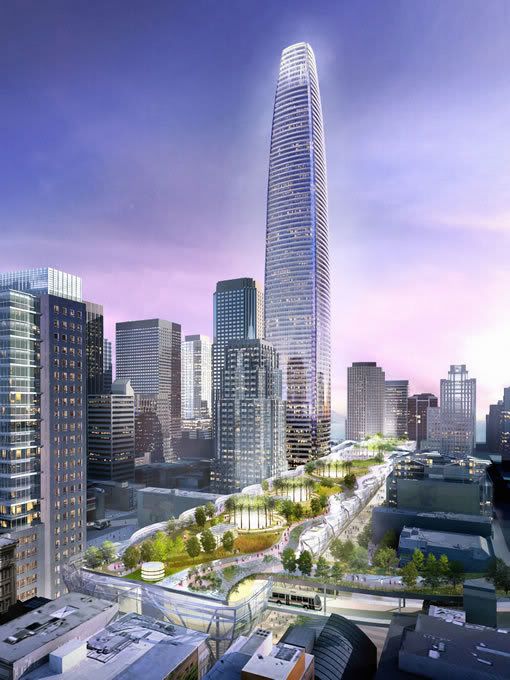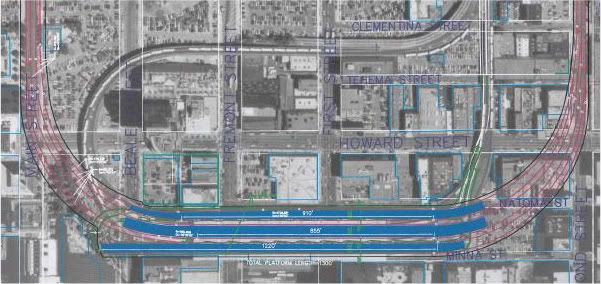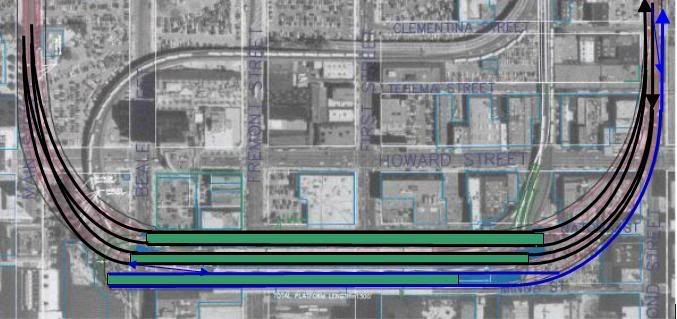(11 am. – promoted by ek hornbeck)
… Hopefully its not a Bonsai
 Burning the Midnight Oil for Living Energy Independence
Burning the Midnight Oil for Living Energy Independence
I was able to get an interesting look into the proposed future of Intercity Travel in the Bay at the Transbay Terminal (TBT) in San Francisco.
Senate Info Heairing on High Speed Rail in California
Note that I am not trying to give “objective reporting” on this issue but rather to give vent to my reaction to watching the hearing online … see The Troubling Discord Between Transbay and High Speed Rail Authorities for a less hot under the collar reaction.
One piece of information is that in California, when one public authority has the funding for sufficient staff and another doesn’t, and it comes to a fight, it is considered fair game for the staffed up authority to toss up spin and red herrings and biased analyses, confident that the other authority does not have the capacity to answer promptly.
The Old “Ambush At The Hearing” Trick
Late on in the piece is the technical guy from the Transbay Terminal (TBT) project putting in all sorts arguments against changing the design of the TBT “train box”, without concern or regard for whether the arguments would be considered fair or impartial by a disinterested third party.
He compares:
- the station stopping time at a through platform to the station stopping time at a terminal platform;
- the terminal turn-around for a regional rail service without food and beverage service on board running between San Jose and San Francisco with a long distance rail service for a train that arrived from Anaheim/LA (or even, in Stage 2, San Diego); and
- the number of services on single routes in Japan and Europe with the number of services for the main northern terminal for multiple routes in California
In other words, red herring tossed out at such regular intervals that quite a pile has accumulated by the time he’s done.
He isn’t the only one with tricks up his sleeve … one of the Senators asked after the terminal capacity at Anaheim. The answer, by the way, was six platform tracks for what is supposed to be the secondary Southern Terminus when the full system is complete … two more than the TBT proposes for HSR, at what is supposed to be the primary Northern Terminus.
How many HSR services should be allowed for?
On the other hand, the California High Speed Rail Authority (CAHSRA) is making claims that seem hard to buy, with nothing more than “our engineers tell us” advanced to back them up. They seem to have asked for an ability to support 12 trains per hour (tph), with 40 minute platform dwell times, claiming that they need 9 to 10 platform tracks.
Does 12 tph with 40 minute dwell times translate to 9 to 10 platforms? That’s 1 1/2 trains per hour per platform, 12 divided by 1 1/2 is 8 in the mathematics that I am accustomed to teaching.
More than that, where is 12 trains per hour coming from? That is a technical requirement for through stations, because the HSR line is designed to permit trains to run at five minute intervals, and along the line, you cannot allow one service to block the next in line.
For the terminal station, the question is the number of services that might start or end at the station. For the California HSR system:
- Connecting LA and the Bay is the backbone transport market for the HSR system … there could well be demand for one LA/Anaheim Express and, half an hour later, one LA/San Diego Express
- The Central Valley will be within three hours by an all-stops HSR to both LA and the Bay … and within two hours of one, the other, or both. So in addition, one all-stations HSR service per hour during the middle of the day is something that needs to be provided for … bearing in mind that while this is a smaller transport market, the HSR will grab a larger share of the total market
- In Stage 2, there will be a San Jose to Sacremento route … but the HSR terminus facilities will be at the TBT. And it will be likely be cheaper to continue the train to terminate at the TBT and sell SJ/SF express tickets than to have a second terminus facility at San Jose.
So this is 4 trains per hour … 1 train per hour on four distinct services … without even considering a Fresno special, or a spur at Mojave for Las Vegas.
And when the 400 seat single level, single set trains start filling up, its better for building ridership to first increase frequency before increasing capacity of each train. 2 LA/Anaheim Expresses per hour and a mix of Express LA/San Diego and Express to LA then all stops to San Diego, plus the all-CV stations and the SJ/Sacramento terminating/originating at TBT, and we are already at 6tph, without any capacity to support the occasional special service like a Fresno Express or, if a branch line is added at Mojave, a Las Vegas service.
Twelve trains per hour may be aiming too high, but six trains per hour seems to be aiming for the bare minimum.
turnaround per train, that would be a capacity of nine (9) trains per hour. That underlines how little spare capacity is available if six (6) trains per hour is supposed to service the terminus for four (or more) routes.
Given the massive cost of building more capacity after the original foundation has been laid, the capability for eight (8) HSR trains per hour seems to be a perfectly reasonable expectation for the primary northern terminus for the system.
And its not like the idea of using the TBT as the main northern terminus for an HSR network is a new idea … San Francisco voters voted for that back in 1999 long before the win on Prop 1A converted it to a project with a better than 50:50 chance of succeeding.
Following the trail of red herring
Now, when someone deploys deceptive comparisons and unbalanced comparisons, I have a reflex reaction … a pile of red herring is normally used to cover something up.
And that something seems to be is a design flaw.
The TBT “train box” includes two “tail tracks”, which allow trains to get off the platform, either for overnight parking or for non-passenger operations like restocking and cleaning, without using up space in the tunnel.
In theory, this means a train can arrive at an arrival platform, unload passengers (which is a very quick operation, since trains have far fewer passengers per door than airplanes), move to the tail platform to make room for the next train, get trash taken out, seats needing deep cleaning looked after, food and beverage restocked, and then get move to the departure platform.
And the TBT tunnel access is designed with three tracks, which eliminates all sorts of potential bottlenecks:
- Both Caltrain and HSR services arrive in the TBT on the central track. At the speeds they are traveling, trains running at three minute intervals is a commonplace occurrence around the world, so one entry track can certainly support up to 20 trains per hour total … 24 if the signalling and switching can be upgraded to two and a half minute separation, as in some busy tunnels on the East Coast.
- A Caltrain service departs from the Caltrain island platform using the “inner” tunnel track, which opens up the platform for an arriving Caltrain service
- After the departing Caltrain service has left, the arriving Caltrain service switches over to the “inner” track to get to the Caltrain island platform
- HSR services run directly to the central arrival island
- HSR services unload, go to the tail track, go to the departure platform, then depart using the “outer” tunnel track
This is a system that allows three different islands to be accessed with little interference, because only two islands get incoming trains, and because each type of service has its own dedicated departure track … so they can arrive in sync, dwell in station for different lengths of time, and leave on their own schedule.
In particular, it allows the HSR trains to be in the station for over 40 minutes, while only occupying the platforms for 30 minutes each, raising the capacity of four platforms to eight trains per hour. Voila!
This also makes it easier to organize efficient movement of passengers, since passengers are either leaving or arriving at each HSR platform … there isn’t a problem at the platform level of departing passengers getting in the way of arriving passengers.
So with this, four platform tracks support can support 8 trains per hour, with 40 minutes station dwell time per train … which is to say, not extremely ambitious, but adequate to the needs of the planned HSR system with enough spare capacity to allow for some growth.
The Design Flaw

The design flaw may not jump out at you, but its in the sketch, taken from the 2003 “locally preferred option” design for the TBT Environmental Impact Report. The right hand side is the tunnel from the present end of the rail line. The left hand is the turn to the tail tracks.
Now, the HSR platforms have to be designed for long trains … once the capacity is filled with 8 car, 400 seat trains, they can be extended to 16-car, 800 seat trains, and then by moving to bi-level trains, 1400 seat trains. That means a 1,320 foot long platform. That means that the bottom two islands are for the HSR and the top island is for Caltrain. The bottom two platforms need to be stretched a bit, and the middle one straightened somehow … but at the hearing, the TBT technical person said that that had all been fixed up.
So, stepping through the pictured design:
- Counting access tracks, three tunnel tracks split up to make six platform tracks. So far, so good.
- For Caltrain to operate as described above, a switch will have to be added so Caltrain services can get from the middle tunnel track to the “inner” tunnel track which leads to the Caltrain platform. And since the outbound train has to leave the Caltrain platform before the inbound train can arrive, that switch is no real bottleneck.
- The two Caltrain platform tracks are connected directly to the Caltrain exit track, so that will work just fine.
- For the HSR trains to operate as described above, the central island is the arriving platform, connected directly to the tunnel track that brings trains in. That will work just fine (well, the curves are awfully tight, so they can’t move as quickly as they should, but if they are all moving at the same slow speed, they will all be in sync).
- That leaves the bottom island as the departing platform. The two platform tracks at this island are connected directly to the HSR exit track, so that will work just fine.
- And the tail tracks … are not connected to the bottom platform track. Instead, the bottom platform track comes to a dead end. That is not just fine. Indeed, assuming that the TBT has the staff that they likely know all of this already, that might be what the pile of red herring is supposed to cover up.
What can be done to straighten up the mess? One approach is to swap the Caltrain platform from top to bottom … and trim a substantial piece from the front (right hand side) of the bottom platform. In fact, trim enough from the front that the switch between the two platform tracks is after the single tunnel track has rounded the corner.

Note that this is just a rough sketch
Trimming off the front of the bottom island allows the middle island to straighten up. Straightening up the middle island allows the top island to straighten up.
The middle island can be straightened up a bit by extending the tail track directly from the middle platform, with switches switches connecting the top island, which gives more room before the platform track must bend to form the rail track.
This might not be enough for 1320 ft. of straight platform, but it’ll be a lot closer … and, after all, the CAHSRA is probably overstating how much straight platform they need, since the platform only needs to be straight for the passenger car portion. A little bit of bend for the driver cars at the front and rear of the train can be tolerated. If this can get 1200 ft. of straight platform with a 60 ft. curved part on either side, that certainly seems like it ought to be OK.
So, if both sides are wrong, who is going to admit it?
The question that puzzles me the most is not the technical one … as tight a squeeze as it may be … but the political one. The TBT authority have made public claims that present a picture of basically being ready to go, except for the fantastical demands of the CAHSR authority. The CAHSR authority has made fallen into the trap of making an ambit claim that they will have to strain to support … but if that costs them the political argument, the fact that the TBT train box is an inadequate design is likely to be lost in the collapse.
The only player that strikes me as having the opportunity to say, “wait a minute, here’s a fix that won’t cost all that much to implement” is Caltrain. But … under the solution above, they are giving up a 900 ft. platform, connected to the tail tracks, for what could end up being a 800 ft. platform, with only one connection to the tail track, and that connection only available when the closest HSR platform track is empty.
To Be Continued …
Anyway, that’s the puzzle. But there’s another possibility … one which might be of more appeal to Caltrain … so I am going to end this with an ellipses.
…

1 comments
Author
… and offering an alternative to the steady stream of 737’s between the Bay and LA is one of the steps we need to take.